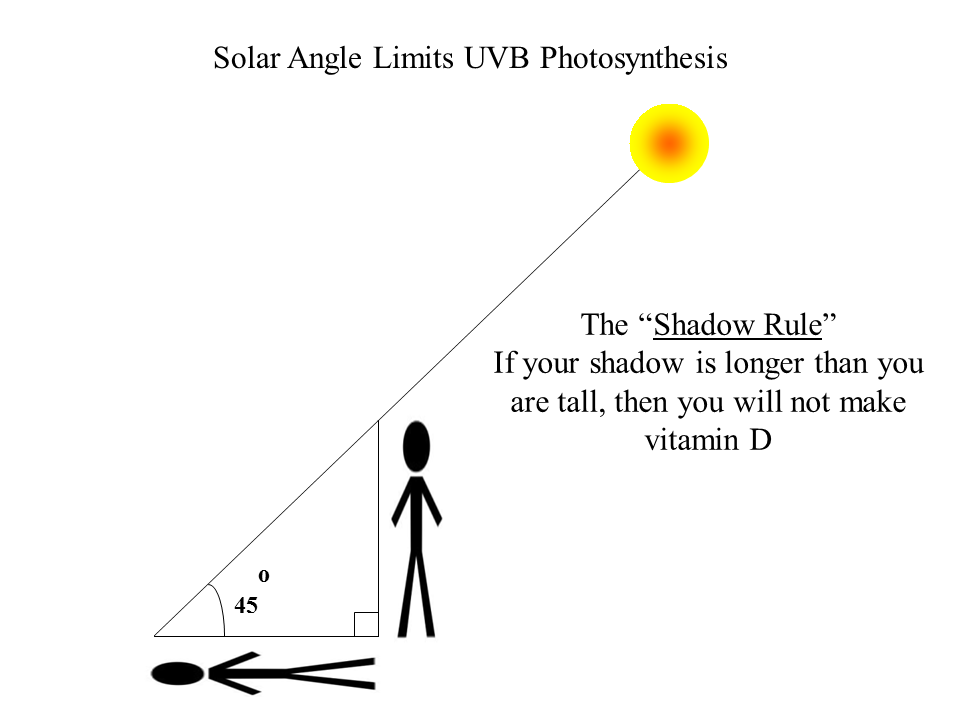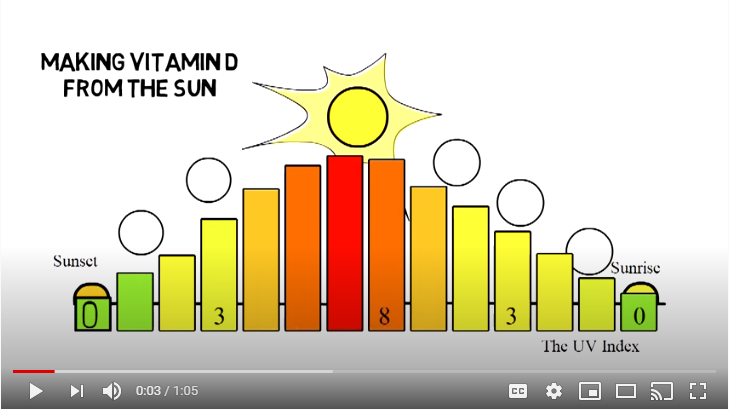Published on May 4, 2020
Key Points
- To make vitamin D, the UV index must be over 3, which usually occurs around midday between 10am and 2pm; it is important to note that depending on the time of year, latitude, weather, air pollution, and geographical location, UV index varies tremendously, as described below
- Early morning and early evening light only provide us with UVA sunlight (good for making nitric oxide), not UVB which is necessary for vitamin D production
- While you are outside in the sunshine, look at your shadow. If your shadow is shorter than your height, the sun is high enough in the sky to let UVB rays shine through and reach the ground, and your skin.
Vitamin D, also known as the “sunshine vitamin,” is synthesized in the skin following direct exposure to UVB rays. However, the UV index must be over 3 to make vitamin D, which usually occurs around midday between 10am and 2pm. It is important to note that depending on the time of year, latitude, weather, air pollution, and geographical location, UV index varies tremendously.
If we need to be outside while the sun is at its peak to make vitamin D, then why have we been told for decades by health organizations to avoid midday sun exposure? For years, Americans have followed guidelines saying to get their sunshine in the morning and later in the afternoon to make vitamin D and prevent burning. However, early morning and early evening light only provide us with UVA sunlight (good for making nitric oxide), not UVB which is necessary for vitamin D production. While it is important to prevent burning, completely avoiding midday sun causes us to miss out on the full benefits of sun exposure. These outdated guidelines may help explain why 80% of Americans are still deficient in vitamin D!
Check out these easy ways to tell if you are making vitamin D from the sun!
Watch the video for some simple ways to know if you are making vitamin D from the sun. First, check the UV index. You can do this on your smart phone using the weather app and plugging in your location. Or, you can use the free dminder app – an app that tracks sunlight and vitamin D production to maximize your body’s vitamin D generation while helping to prevent burning. If the UV index is over 3, then you are in the clear for making vitamin D! If not, the sunlight isn’t strong enough for your skin to be able to make any.

Second, while you are outside in the sunshine, look at your shadow. Is it shorter than you are? All you have to do is look at the ground to see if the length of your shadow is shorter than your height. It’s that easy! If your shadow is shorter than your height, the sun is high enough in the sky to let UVB rays shine through and reach the ground, and your skin!

Some other important factors to consider when trying to make vitamin D from sun exposure:
Latitude and season – those closer to the equator, where the midday sun is high in the sky throughout the year, have the ability to produce vitamin D year-round, whereas those north of about 34 degrees latitude (approximately Los Angeles, CA, or Atlanta, GA) experience a “vitamin D winter” for some period of time between fall and early spring when the sun never gets high enough in the sky to enable vitamin D production.
Clothing and sunscreen – greater amounts of vitamin D are made when more skin is exposed, without sunscreen, especially the back and shoulders, as these contain the most surface areas on your body. It is better to expose more skin for less time to ensure you do not overexpose yourself and burn. Ideally your skin should be exposed to the sun on a 90-degree angle.
Time in the sun – under the right conditions, the body can produce 10,000 to 25,000 IU of vitamin D with full body exposure in just under the time it takes for your skin to turn pink, but not on your first day out in the sun after a long winter. You should increase your exposure time gradually as this allows your skin to adapt to the sun’s intensity. As the season gets warmer and sunnier, exposed skin will adapt to produce a tan. You never have to worry about making too much vitamin D from the sun because your body self-regulates by stopping production when it has reached its limit.
Skin color – it will take an individual with darker skin more time in the sun compared to a lighter skinned individual to produce the same amount of vitamin D. It is important to be mindful of your skin type and avoid burning.
Age – as a person ages, their skin’s ability to produce vitamin D decreases.
Time of day – vitamin D production is strongest mid-day between 10am and 2pm. Follow the Shadow Rule – if you are taller than your shadow is long, then your exposed skin can make vitamin D.
Also keep in mind that the quality of sun exposure is important for vitamin D synthesis. Cloud coverage, air pollution, sunscreen, and shade cast off from buildings all disrupt the direct contact of sunlight on our skin.
Do You Have Enough Vitamin D to Support a Healthy Immune System?
Do you know what your vitamin D level is? Be sure to test today to find out, and take steps to keep it within a target of 40-60 ng/ml or 100-150 nmol/L! Give your immune system the nutrients it needs to support a healthy you and protect yourself from unnecessary diseases.
Through GrassrootsHealth Nutrient Research Institute, you can also test your essential elements magnesium, copper, zinc and selenium, toxins such as lead, mercury and cadmium, as well as your omega-3 levels, inflammation levels and thyroid stimulating hormone (TSH) level. Find out your levels today! Log on to the test selection page (click the link below) to get your tests and see for yourself if your levels can be improved.
Make sure you track your results before and after, about every 6 months! Click Here to Access the Test Page
How can I track my nutrient intake and levels over time?
To help you track your supplement use and nutrient levels, GrassrootsHealth has created the Personal Health Nutrient Decision System called
For each specific supplement, you can track what days you take it, how much, and many other details. This will help you know your true supplemental intake and what patterns of use work for you to reach and maintain optimum nutrient levels. Check it out today!








